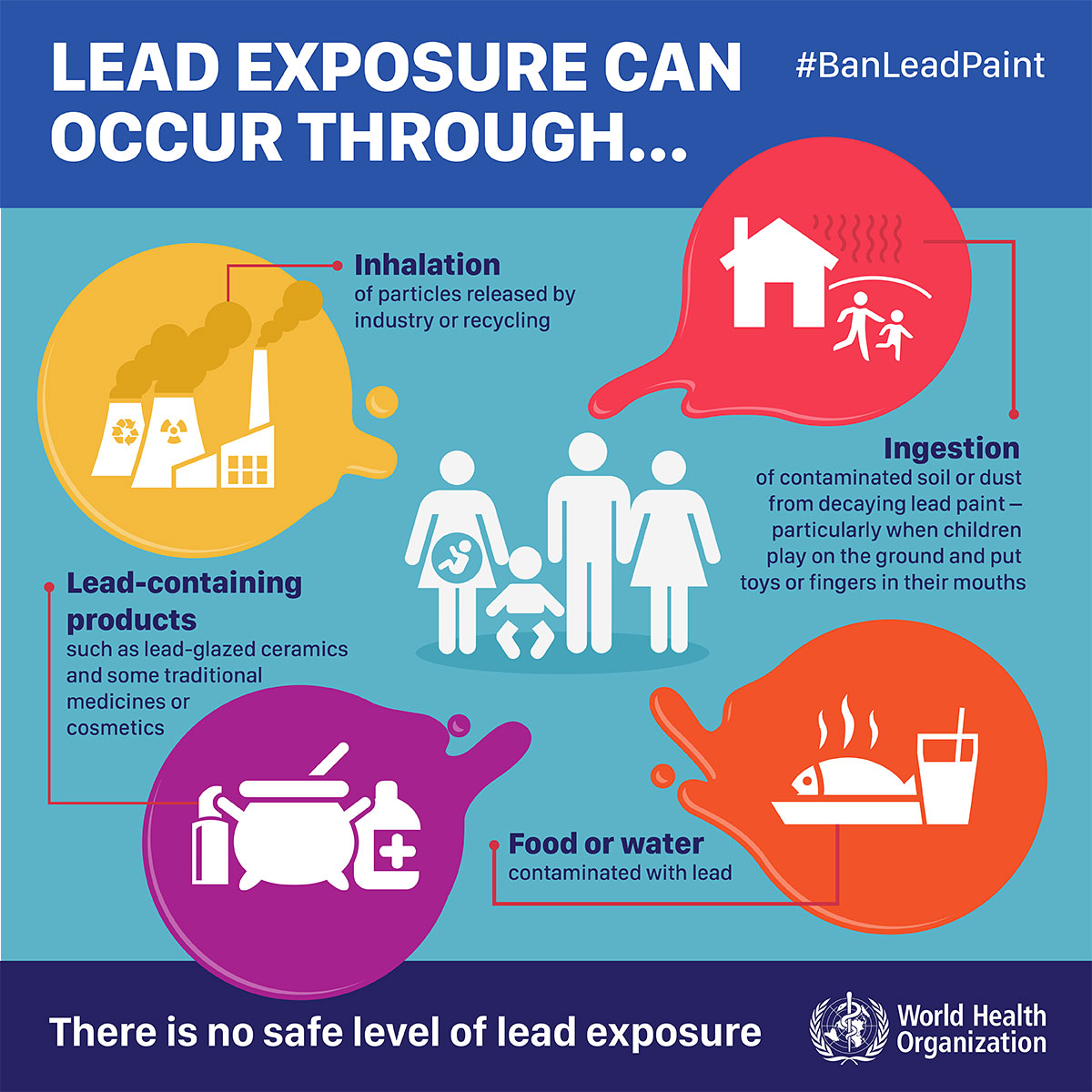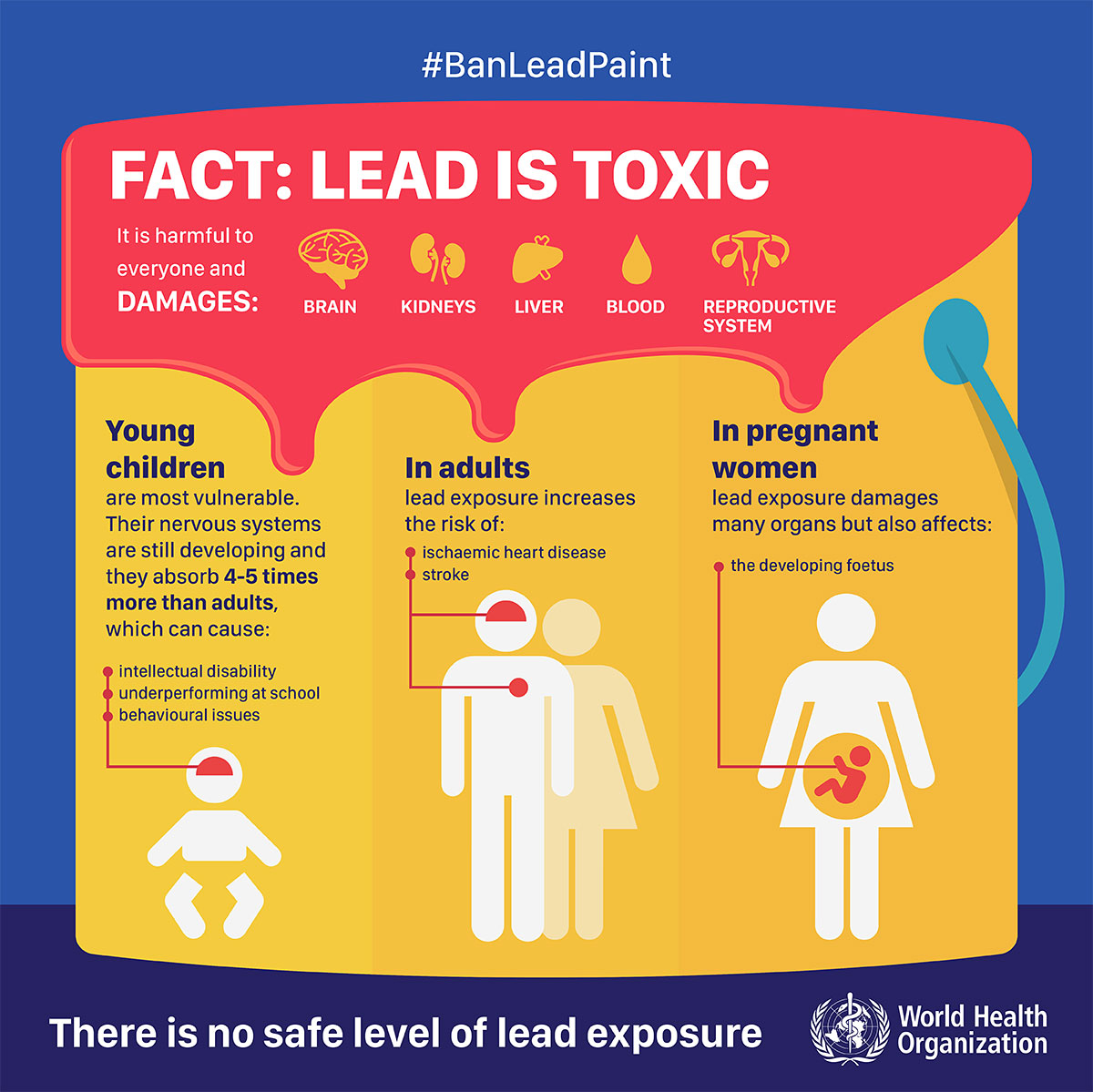Lead poisoning is a preventable yet concerning public health issue that demands immediate attention. This condition occurs when lead accumulates in the body, usually through exposure to lead-contaminated products, soil, water, or paint. Lead poisoning primarily affects young children and can lead to a wide range of cognitive, behavioral, and developmental impairments.
Nurses play an important role in recognizing the signs and symptoms of lead poisoning, educating families on potential sources of lead exposure, and advocating for preventive measures to reduce risks.
Table of Contents
- What is Lead Poisoning?
- Statistics and Incidences
- Causes
- Clinical Manifestations
- Assessment and Diagnostic Findings
- Medical Management
- Nursing Management
What is Lead Poisoning?
Lead poisoning is a worldwide pediatric problem.
- Lead is a ubiquitous and versatile metal; it has been extensively used since ancient times, and the history of public exposure to lead in food and drink is extensive.
- Lead poisoning (also known as plumbism) was common in Roman times because of the use of lead in water pipes and in wine containers.
- In 1904, the Australian physician J. Lockhart Gibson concluded that lead paint in the home was responsible for poisoning children; despite Gibson’s work, and subsequent confirmation of it in the US medical literature, lead was not banned from US household paints until 1978.
- In 1991, the Centers for Disease Control and Prevention (CDC) defined blood lead levels (BLLs) ≥10 µg/dL as the “level of concern” for children aged 1–5 years.
- In May 2012, the CDC replaced the term “level of concern” with an upper reference interval value defined as the 97.5th percentile of BLLs in US children aged 1–5 years from two consecutive cycles of the National Health and Nutrition Examination Survey (NHANES).
Statistics and Incidences
According to the Centers for Disease Control and Prevention (CDC), the percentage of confirmed blood lead levels (BLLs) ≥10 µg/dL in US children younger than 72 months fell from 7.61% in 1997 to 0.56% in 2013.
- Nevertheless, the CDC estimates that at least 4 million US households have children living in them that are being exposed to high levels of lead, and approximately half a million US children age 1-5 years have blood lead levels above 5 µg/dL, the reference level at which CDC recommends public health actions be initiated.
- Children who belong to minority populations or low-income families or who live in older homes are, particularly at risk.
- Lead continues to be a significant public health problem in developing countries.
- In general, children with heavy exposure to automobile exhaust (in countries where leaded gasoline is still sold), lead-based paint, or home-industry manufacture of batteries, ceramics, or painted artifacts have high lead burdens.
- Overall, from 1999-2002, non-Hispanic blacks and Mexican Americans had higher percentages of elevated BLLs (1.4% and 1.5%, respectively) than did non-Hispanic whites (0.5%).
- Lead poisoning chiefly affects children younger than age 6 years and adults in lead-risk occupations.
Causes
Lead toxicity may be caused by inorganic or organic lead.
- Inorganic lead. Most cases of lead poisoning are caused by inorganic lead; lead may enter the body through ingestion, inhalation, or transdermal absorption; ingestion is the most common source of lead poisoning in children because of their normal hand-to-mouth activities.
- Organic lead. However, organic lead, such as tetraethyl lead, may enter through the skin; tetraethyl lead, the main organic compound in leaded gasoline, is converted in the body to triethyl lead and inorganic lead.
Clinical Manifestations
The clinical picture associated with lead poisoning is vague; symptoms are not specific enough to alarm the physician about lead toxicity.
- Pallor. No specific physical signs for lead poisoning are recognized, but patients may exhibit pallor (due to associated anemia).
- Impaired consciousness. The child may become lethargic or may lose consciousness after a considerable amount of time from contact with lead.
- Bradycardia. There is a decrease in the heart rate of the child.
- Hypertension. Increase in blood pressure is one of the signs of increased intracranial pressure, a common finding in children affected by lead.
- Respiratory depression. The child may experience shortness of breath as a sign of respiratory depression.
Assessment and Diagnostic Findings
In the early 1990s, both the Centers for Disease Control and Prevention (CDC) and the American Academy of Pediatrics (AAP) recommended universal screening for lead toxicity in children at 1 and 2 years of age.
- Whole blood lead level (BLL) is the criterion standard for confirming the diagnosis of lead poisoning; for convenience, a fingerstick capillary lead level has been used for screening; properly collected capillary samples have a 10% false-positive rate; once an elevated lead level is detected, a venous lead level is assessed for confirmation.
- Erythrocyte protoporphyrin. Erythrocyte protoporphyrin (EP) may be obtained in selected patients; lead toxicity affects heme synthesis at several steps; this includes interference with the enzyme ferrochelatase, leading to the accumulation of EP; EP is easily detected because it fluoresces easily; EP is an adjunct for the diagnosis in the presence of elevated lead levels of 55 mcg and higher.
- Hair samples. In Russia, hair sample is the standard for lead poisoning screening.; however, studies have demonstrated that blood lead specimens are more sensitive than hair samples in detecting lead exposure.
- Abdominal radiography. Presence of radiopaque flakes is a clear indicator of pica.
- Long-bone radiography. Radiodensity may be detected at the distal metaphyseal area; these indications, known as lead lines, are true growth arrest lines and, although not pathognomonic, are associated with chronic lead exposure
Medical Management
Treatment of lead toxicity involves the prevention of further lead exposure, decontamination, chelation, and supportive therapy.
- Decontamination. Decontamination may be performed in patients with acute lead ingestion in whom lead paint chips are identified on plain abdominal radiographs; gastric lavage may be performed; secure the airway before the initiation of gastric lavage in an obtunded child with acute lead ingestion.
- Chelation. Use of chelating agents is recommended for children with venous lead levels of 45 μg/dL or higher; these include oral succimer and parenteral calcium disodium edetate (calcium EDTA) and British antilewisite (BAL; dimercaprol).
- Supportive therapy. Certain children may develop acute lead encephalopathy; in such circumstances, protection of the airway via endotracheal intubation may be necessary; in the event of seizures, benzodiazepines are indicated; maintenance of seizure control with phenobarbital may be needed; if seizures are difficult to control, presume the presence of increased intracranial pressure and pursue measures to decrease it (eg, hyperventilation, mannitol, steroids).
- Primary prevention. Parents should be educated about sources of lead, the common behavior involved (ie, pica), and the hazards associated with lead exposure on children’s development; nutritional assessment is of particular importance because lead absorption is enhanced by improper dietary intake, especially in the presence of high fat intake and/or deficiency of certain elements, such as calcium and iron.
- Secondary prevention. Secondary prevention focuses on the early detection of lead poisoning; the CDC has devised screening criteria to determine which children are at high risk for lead poisoning; screening of BLLs should be carried out according to these criteria.
- Dietary measures. The diet should be adequate in energy (caloric) intake and replete with calcium, zinc, and iron; data from the Normative Aging Study suggest that low dietary intake of vitamin D may increase accumulation of lead in bones, whereas low dietary intake of vitamin C and iron may increase lead levels in blood in subjects who range in age from middle-aged to elderly.
Pharmacologic Management
Medications for a child who has lead poisoning include:
- Chelating agents. These agents bind to lead and promote its excretion; patients receiving chelation therapy must be closely monitored because of the agents’ potential toxicities; Dimercaprol was first developed as an antidote for lewisite toxicity; it is water soluble and rapidly crosses the blood-brain barrier; Dimercaprol forms a nonpolar compound with lead that is excreted in bile and urine; it is the drug of choice in patients with acute lead encephalopathy, in whom the first dose is given and then the second dose is given combined with calcium EDTA after a 4-hour interval.
Nursing Management
Nursing care for a child who has lead poisoning includes:
Nursing Assessment
Assessment of a child who experiences lead poisoning involves:
- History. Assess for the presence of lead in any household furniture or fixture, any lead-containing materials, and lead-contaminated food or beverages.
- Physical examination. Assess the child for signs of lead poisoning, such as hyperactivity or lethargy, irritability, pallor, and signs of shock.
Nursing Diagnoses
Based on the assessment data, the major nursing diagnoses are:
- Delayed growth and development related to effects of lead on the brain.
- Disorganized infant behavior related to irritability and lethargy.
- Ineffective breathing pattern related to shortness of breath.
Nursing Care Planning and Goals
The major goals are:
- The child will have a normal blood lead level.
- The child will be able to communicate and interact with the parents.
- Breathing pattern will return to normal.
Nursing Interventions
The nursing interventions are:
- Reduce lead exposure. Children with symptomatic lead poisoning (with or without encephalopathy) must be treated only at a pediatric center that has an intensive care unit; they should be managed by a multidisciplinary team that includes, as needed, critical care, toxicology, neurology, and neurosurgery; the child’s neurological status and fluid balance must be carefully monitored.
- Medication administration. Administer edetate calcium disodium or EDTA, as ordered, intravenously because intramuscular administration is painful.
- Monitor for side effects. All chelating drugs may have toxic side effects, and children being treated must be carefully monitored with frequent urinalysis, blood cell counts, and renal function tests.
- Education. Educate the family about lead poisoning prevention and nutrition.
- Remove lead-containing materials. Throw out old painted toys if you do not know whether the paint contains lead; avoid canned goods from foreign countries, and the walls must be covered with a paneling or Masonite.
Evaluation
Goals are met as evidenced by:
- The child will have a normal blood lead level.
- The child will be able to communicate and interact with the parents.
- Breathing pattern will return to normal.
Documentation Guidelines
Documentation in a child who underwent lead poisoning includes:
- Individual findings include factors affecting, interactions, the nature of social exchanges, and specifics of individual behavior.
- Characteristics of vomitus.
- Cultural and religious beliefs, and expectations.
- Plan of care.
- Teaching plan.
- Responses to interventions, teaching, and actions performed.
- Attainment or progress toward the desired outcome.



